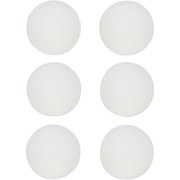Create Your Own Planet (#18)
Our Solar System
Our solar system includes the Sun, Mercury, Venus, Earth, Mars, Jupiter, Saturn, Uranus, Neptune, Dwarf Planets, and moons.
EARTH
Earth is the third planet from the Sun, the fifth largest planet, and is the densest of all planets in our Solar System. Earth is a rocky, terrestrial planet, it's surface has mountains, valleys, canyons, plains, rivers, and oceans. About 70% of Earth's surface is made up of water, the rest is made up of islands and continents. Earth is the only known planet in our solar system to be able to support life.
Creating Your Own Planet:
After exploring and researching about Earth and other planet's, students can use their knowledge of planet systems such as the materials it is composed of, land-forms, climate and weather systems, and environments and lifeforms, to create and describe their own planet.
Materials:
- Planet structure- Styrofoam, floral foam, paper-mache, cardboard, clay
- Decoration- Paint, puffy paint, glitter, stickers, figurines
- Supplies- Paint brushes, glue, newspaper
Instructions:
- Encourage students to use a variety of materials to create a planet of their very own. Consider the shape, decorations, and textures used to create the planet, how do these features express the composition, land-forms, climate, environments, and lifeforms of the planet? Describe these features and why they were chosen for the planet.
My Planet:
Nuratue (nur-a-tu):
A ring of materials and gases surrounds the planet
Three moons orbit the planet
The planets surface contains large continents, small islands, and bodies of water. Nuratue has three major climate and environmental types.
- The red lands are Mediterranean climates with natural forests and mountainous environments. They experience seasons like autumn that are cool and rainy with plant foliage and summers that are dry and warm to hot temperatures. Animals such as bears, llamas, and foxes live in these environments.
- The peach lands are tropical climates with rain forests and flat plains. Temperatures are usually warm to hot and experience a spring season year around. Birds, frogs, monkeys, and prairie animals occupy these lands.
- The yellow lands are dry, semiarid climates, environments include desserts and sandy beaches. Summers is the only season year around, days are hot and dry, and nights are cool. Rainfall is low in these areas, lizards, snakes, and dragons are found in the dessert area and turtles, birds, and crabs at the beaches.
The waters are warm and contain a variety of aquatic animals and merpeople.
On planet Nuratue, animals and humans live together in peace.
The intent of Nuratue is to nurture promote the growth of nature and all its life forms.
Children's Activities Related to Earth, Space and Planets:
- Research different types of Earth land-forms, create a model or drawing of the land-form and describe how it was created.
- Model how a glacier moves and how it changes the environment or shape of the land.
- Researching different climate types around the world. Create a model or drawing that describes the weather, environment, land-forms, and animals of a specific climate type.
- Erosion vs weathering experiment.
- Research and explore each planet, have students create a step book to display the order and information about each planet, include a drawing and facts about each planet.
- Use a globe and a lamp to demonstrate how the Earth turns to create night and day, how the Earth rotates around the sun to create seasons, and how the moon reflects the suns light to create moon phases.
Children's Books Related to Earth, Space, and Planets:
Video/links:
Information, games, and activities for kids https://spaceplace.nasa.gov/


































Comments
Post a Comment